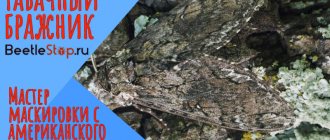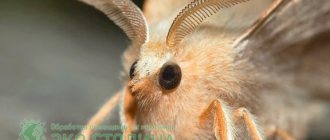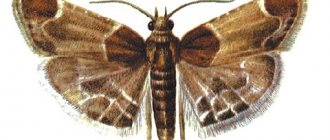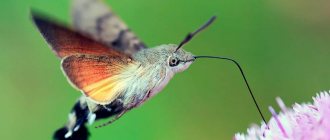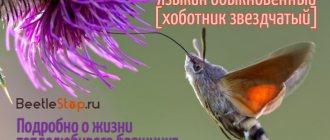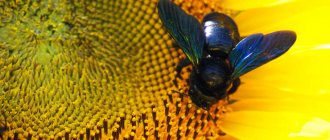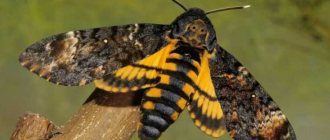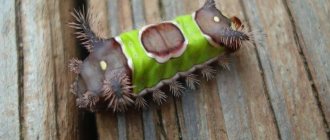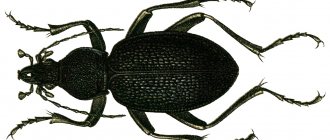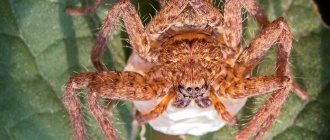Hawk moths are a large family that includes 1,200 species of large and medium-sized butterflies. Because of their special way of feeding, they were nicknamed “northern hummingbirds.” One of the most prominent representatives of the family is the death's head hawk moth. Its wingspan reaches 130 mm, its body weight is 9 g. People’s close attention to the butterfly is explained by the unusual pattern on its chest. The yellow figure on a dark background resembles a human skull. The frightening picture gave rise to various superstitions associated with the moth.
Origin of the species and description
Photo: Death's head butterfly
The death's head belongs to the hawk moth family. Its Latin name, Acherontia atropos, combines two designations that brought fear to the inhabitants of Ancient Greece. The word “Acheron” means the name of the river of sorrow in the kingdom of the dead, “Atropos” is the name of one of the goddesses of human destinies, who cut the thread identified with life.
The ancient Greek name was intended to describe the horrors of the underworld. The Russian name of the moth Death's Head (Adam's Head) is associated with its coloring - there is a yellow pattern on the chest, shaped like a skull. In many European countries, the hawk moth bears a name similar to the Russian one.
Video: Death's Head Butterfly
The species was first described by Carl Linnaeus in his work “The System of Nature” and named it Sphinx atropos. In 1809, an entomologist from Germany, Jacob Heinrich Laspeyres, allocated the hawkmoth to the genus Acherontia, to which it is still classified today. This genus belongs to the taxonomic rank Acherontiini. Within the rank, interspecific kinship has not been fully studied.
There are a huge number of insect species in the world, but only this creature has been awarded the creation of so many signs, legends and superstitions. Unsubstantiated speculation led to persecution, persecution and destruction of the species as a harbinger of trouble.
Interesting fact: The artist Van Gogh, who was in the hospital in 1889, saw a moth in the garden and depicted it in a painting he called “Death's Head Hawkmoth.” But the painter made a mistake and instead of the famous Adam’s head he painted the “Peacock-Eyed Pear”.
Sources[ | code]
- ↑ JJ de Freina.
Die Bombyces und Sphinges der Westpalaearktis. Noctuoidea, Sphingoidea, Geometoidea, Bombycoidea Auflage. - München: EFW Edition Forschung & Wissenschaft Verlag GmbH, 1987. - Vol. 1. — 405 p. — ISBN 3-926285-00-1. - Lampert K. Atlas of butterflies and caterpillars. - Minsk: Harvest, 2003. - 735 p. — 5000 copies. — ISBN 985-13-1664-4
- Striganova B. R., Zakharov A. A.
Five-language dictionary of animal names: Insects (Latin-Russian-English-German-French) / . - M.: RUSSO, 2000. - 560 p. — 1060 copies. — ISBN 5-88721-162-8. - Nidon K., Peterman I., Scheffel P., Shayba B. Plants and animals. A Naturalist's Guide. – M.: Mir, 1991. – 263 p.
- Brandt E.K.
Hawk Moth Death’s Head // Encyclopedic Dictionary of Brockhaus and Efron: in 86 volumes (82 volumes and 4 additional). - St. Petersburg, 1890-1907. - ↑ K. Lampert.
Atlas of butterflies and caterpillars. - Minsk: Harvest, 2003. - 735 p. — 5000 copies. — ISBN 985-13-1664-4. - Helgard Reichholf-Rim.
Butterflies. The most popular reference book. - M.: Astrel, 2002. - ↑ Ler P.A.
Key to insects of the Russian Far East. T. 5. Caddisflies and Lepidoptera. Part 3. - 2001. - Izersky V.V.
Bombicoid lepidoptera and corydalis of Siberia and the Far East. - Kyiv, 1999. - ↑ N. A. Kun.
Myths of Ancient Greece. - M.: AST, Astrel, 2004. - 400 p. — 10,000 copies. — ISBN 5-17-025345-1. - ↑ Kaabak L.V., Sochivko A.V.
Butterflies of the world. - M.: Avanta+, 2003. - ISBN 5-94623-008-5. - Fauna Europaea, Version 1.3, 04/19/2007.
. Retrieved November 5, 2009. - ↑ Ian J. Kitching: Phylogeny of the death's head hawkmoth, Acherontia, and related genera (Lepidoptera: Sphingidae, Acherontiini)
, Systematic Entomology 28 (2003) 71–88. - ↑ Helgard Reichholf-Rome.
Butterflies. The most popular reference book. - M.: Astrel, 2002. - ↑
- Rolf Reinhardt, Kurt Harz: Wandernde Schwärmerarten. Totenkopf-, Winden-, Oleander- und Linienschwärmer. In: Die Neue Brehm-Bücherei Bd. 596. 2., unveränderte Auflage. Westarp Wissenschaften, Magdeburg, Heidelberg, Berlin und Oxford 1996, ISBN 3-89432-859-2, S. 32.
- Pittaway, AR. 1993. The hawkmoths of the western Palaearctic. Harley Books, London.
- Dubatolov VV, Titov SV 2011. Discovery of Acherontia atropos
L. (Lepidoptera, Sphingidae) in North-East Kazakhstan // Amurian zoological journal. Vol. III. No. 1. P. 58—59, color plate V. - Sitnikov, 2009; cit. from: Dubatolov, Titov, 2011.
- ↑
- Akimushkin I. I.
Animal world. - M.: Mysl, 1993. - T. 3. - ISBN 5-244-00444-1. - ↑
- (August 15, 2003). Retrieved November 14, 2009.
- (August 15, 2003). Retrieved November 14, 2009.
- ↑ Efetov K. A., Budashkin Yu. I.
Butterflies of the Crimea (Higher Lepidoptera). - Simferopol: Tavria, 1990. - 112 p. — (Environmental protection). - Rolf Reinhardt, Kurt Harz: Wandernde Schwärmerarten.
Totenkopf-, Winden-, Oleander- und Linienschwärmer. Die Neue Brehm-Bücherei Bd. 596, Westarp & Spektrum, Magdeburg, Heidelberg, Berlin und Oxford 1996, ISBN 3-89432-859-2. - ↑ N. B. Nikitsky, A. V. Sviridov.
Insects of the Red Book of the USSR. - M.: Pedagogy, 1987. - P. 176. - Shaparenko O. Yu., Shaparenko S. O.
Chervona book of Ukraine. — 2nd ed., with changes. - Kharkov: Torsing Plus, 2007. - 384 p. — 3000 copies. — ISBN 978-966-404-597-8. - Vladimir Alekseev.
Butterflies in myths and legends. - Bustard, 2006. - 192 p. - (Historical album). — ISBN 5-358-00249-9. - Harrison, R: . Van Gogh Letters
. WebExhibits (funded in part by US Department of Education, Fund for the Improvement of Postsecondary Education) (2011). Retrieved April 18, 2011. - . Permanent Collection
. Van Gogh Museum (2005—2011). Retrieved April 15, 2011.
Appearance and features
Photo: Death's head hawk moth butterfly
The Adam's head species is one of the largest among European moths. Sexual dimorphism is vague and females differ little from males.
Their sizes reach:
- length of the front wings - 45-70 mm;
- wingspan of males - 95-115 mm;
- wingspan of females - 90-130 mm;
- weight of males - 2-6 g;
- females weigh 3-8 g.
The fore wings are pointed, twice as long as they are wide; the rear ones are one and a half, there is a small notch. The front ones have a smooth outer edge, the rear ones are beveled towards the edge. The head is dark brown or black. On the black-brown chest there is a yellow pattern that looks like a human skull with black eye sockets. This drawing may be completely absent.
The lower part of the chest and abdomen are yellow. The color of the wings can vary from brown-black to ocher-yellow. The pattern of moths may vary. The abdomen is up to 60 millimeters long, up to 20 millimeters in diameter, covered with scales. The proboscis is strong, thick, up to 14 millimeters, and has cilia.
The body is cone-shaped. The eyes are round. The labial palps are pressed tightly to the head and covered with scales. The antennae are short, narrowed, and covered with two rows of cilia. The female has no eyelashes. The legs are thick and short. There are four rows of spines on the paws. There are two pairs of spurs on the hind tibia.
So we figured out what the Death's Head butterfly looks like. Now let's find out where the Death's Head butterfly lives.
general information
Hawkmoths are amazing insects: outwardly, adult individuals resemble hummingbirds. Some species of nocturnal butterfly fly only during the day, others are active at night or in the morning. When an unusual creature with an original body and wing color appears in a garden or vegetable garden, many owners do not understand what type of butterfly it is.
Characteristics:
- the size of adult insects is up to 110 mm, the proboscis is up to 100 mm long, the wingspan is from 65 to 120 mm;
- the flight speed is impressive - up to 50 km/h;
- hummingbird butterflies hover over flowers, flutter, quickly flap their wings, and feed on sweet nectar;
- the complete cycle of transformation is characteristic of unusual creatures. First, the egg appears, then the larva (caterpillar), then the pupa and finally the adult (butterfly). The life cycle takes from 30 to 45 days; during the summer period, two generations of amazing creatures often alternate;
- The emergence of adult insects begins at the end of June. Bright creatures look spectacular against the backdrop of young greenery. Butterflies flutter around flowering trees and shrubs: pear, apple, chestnut, lilac;
- The caterpillars are large - up to 125 mm, most species have a bright color, and the original pattern on the back and sides is often noticeable. Some species are painted in fantastic colors: green with a lemon tint, white with black and yellow spots on the sides, brownish-gray with “painted” eyes on the front of the body. Growing individuals look like creatures from another planet;
- A characteristic feature of caterpillars is a “horn” at the end. The color of the formation depends on the type of butterfly, for example, in the lilac hawkmoth it is black on one side and yellow on the other, in the ocellated variety it is blue;
- Before pupation, the color of the growing insect changes. During this period of development, the caterpillar accumulates enough nutrients and then burrows into the ground. After 18 days, a beautiful butterfly emerges from the pupa. While the wings dry, the insect sits in place, as soon as it can fly, the hummingbird butterfly goes to look for a sexual partner to maintain the population;
A few more facts:
- A caterpillar is a creature that is soft to the touch, calm, and crawls quite slowly. If you take it in your hands, no unpleasant sensations or disgust appear. The growing individual sits calmly on the palm, moves slowly, and willingly “poses” for the camera.
- caterpillars feed on young leaves. The wine hawk moth eats greenery and settles on the grapevine. The larva is large, warlike in color, and has a kind of spike at the end. The creature is so unusual that many owners do not destroy the pests, but watch them, hoping to endure the unpleasant period and later see a beautiful hummingbird butterfly on the site;
- The tongue hawk moth resembles a small bird. When a beautiful creature appears at their summer cottage, many children say that they saw an unusual bird next to the flowers;
- The Death's Head Hawkmoth gets its name from its distinctive skull-like pattern on its chest, like the emblem on a pirate flag. The largest butterfly of the hawkmoth species feeds on the sap of young trees and honey. The insect often climbs straight into the hive, makes sounds reminiscent of a young queen, and steals honey without hindrance: the bees take her for a relative and do not touch her;
- the bedstraw species is most often found in the middle zone. Long proboscis, dense body, color - a combination of brown and beige, with orange areas visible on the tips of the wings.
Unusual insects are often called sphinxes. The reason is that the disturbed caterpillar raises its front part, takes on a threatening appearance, and freezes in the pose of a sphinx. Hence the name.
Types of hawk moths:
- euphorbia;
- wine;
- pine;
- hawkmoth "death's head";
- ocular;
- oleander;
- bindweed;
- lilac;
- proboscis hawk moth and others.
On a note!
There are about 1,000 species of “northern hummingbirds” on the planet. Some species make long-distance flights, migrate from one end of the country to another, or cover distances between continents.
Where does the death's head butterfly live?
Photo: Adam's head butterfly
Its habitat includes Africa, Syria, Kuwait, Madagascar, Iraq, the western side of Saudi Arabia, and Northeastern Iran. Found in Southern and Central Europe, the Canary and Azores Islands, Transcaucasia, Turkey, Turkmenistan. Vagrant individuals were observed in the Palearctic, the Middle Urals, and North-East Kazakhstan.
The habitats of Adam's head directly depend on the time of year, since the species is migratory. In the southern regions, moths live from May to September. Migrating hawk moths are capable of flying speeds of up to 50 kilometers per hour. This figure gives them the right to be record holders among butterflies and allows them to migrate to other countries.
In Russia, the Death's Head was found in many regions - Moscow, Saratov, Volgograd, Penza, the North Caucasus and the Krasnodar Territory; it can most often be found in mountainous regions. Lepidoptera choose a wide variety of landscapes for their residence, but most often they settle near plantations, fields, woodlands, and valleys.
Butterflies often choose areas near potato fields. When digging up potatoes, you come across many pupae. In Transcaucasia, individuals settle at the foot of the mountains at an altitude of up to 700 m above sea level. During the migration period it can be found at an altitude of 2500 m. The flight time and its distance depend on weather conditions. At migration sites, lepidoptera form new colonies.
Habitat
This type of butterfly is widespread in Africa, also on the European continent including the Russian Federation, Central Asia and the Middle East. Here are several regions in the Russian Federation where this type of insect has ever been discovered, or lives to this day:
- In Moscow;
- In Smolenskaya;
- In Saratovskaya;
- In Astrakhan;
- In Penza;
- In Krasnodar.
The butterfly's habitat in BV:
- Syria;
- Türkiye;
- Northern Iran;
Middle Asia:
- Turkmenistan;
- Kazakhstan;
The homeland of this European species of insects is the African continent. Some species of butterflies that live in the southern part of the EU require constant staffing from guests flying from the southern regions.
What does the death's head butterfly eat?
Photo: Death's head moth
Imagoes are partial to sweets. The nutrition of adult individuals is an important factor not only in maintaining vital functions, but also in the maturation of eggs in the body of females. Due to their short proboscis, moths cannot feed on nectar, but they can drink tree sap and juices flowing from damaged fruits.
However, insects very rarely feed on fruits, since when sucking honey, juice or collected moisture, they prefer not to be in a state of flight, but to sit on the surface near the fruit. The Death's Head butterfly loves honey and can eat up to 15 grams at a time. They enter hives or nests and pierce the honeycombs with their proboscis. Caterpillars feed on the tops of cultivated plants.
They especially like:
- potato;
- carrot;
- tomato;
- tobacco;
- fennel;
- beet;
- eggplant;
- turnip;
- physalis.
The caterpillars also eat the bark of trees and some plants - belladonna, datura, wolfberry, cabbage, hemp, nettle, hibiscus, ash. They cause significant harm to shrubs in gardens by eating foliage. Most of the time, the caterpillars are underground and only come out to feed. They give preference to nightshade plants.
Individuals feed alone and not in groups, so they do not cause much harm to plants. Unlike pests, they do not destroy crops, since they are an endangered species and do not cause mass raids. Plants are fully restored in a short time.
Benefit or harm
The hawk moth is a rather neutral insect that can cause some harm, but also brings benefits.
Only tobacco hawk moth can significantly harm tomatoes and other nightshades.
But positive properties :
- is a pollinator;
- used in neurobiology;
- grown for reptile food;
- live at home and create collections.
The African hawk moth is the only pollinator of the Madagascar orchid. Only this species has such a long proboscis, about 30 cm. He is the only pollinator!
Features of character and lifestyle
Photo: Death's head butterfly
This species of butterfly is nocturnal. During the day they rest, and at dusk they begin to hunt. Until midnight, moths can be observed in the light of lamps and poles, which attracts them. In the rays of bright light they spin beautifully, performing mating dances.
Insects can make squeaking sounds. For a long time, entomologists could not understand what organ formed them and believed that it came out of the stomach. But in 1920, Heinrich Prell made a discovery and found out that the squeak appears as a result of the vibration of a growth on the upper lip when the butterfly sucks in air and pushes it back.
Caterpillars can also make squeaks, but this is different from the sounds of adults. It is formed as a result of friction of the jaws. Before rebirthing into a butterfly, the pupae can make a sound if disturbed. Scientists are not one hundred percent sure what it serves, but most agree that insects make them to scare away strangers.
In the caterpillar stage, insects spend almost all their time in burrows, crawling to the surface only to eat. Sometimes they don’t even stick out completely from the ground, but reach out to the nearest leaf, eat it and hide back. The burrows are located at a depth of 40 centimeters. They live like this for two months and then pupate.
Honey thieves
Hawkmoths do not live on nectar alone; they also have great respect for honey. Butterflies do not hesitate to climb into beehives for this delicacy. And what’s most amazing is to return from there not only alive and healthy, but also well-fed. How do bees tolerate such brazen attacks?
Entomological scientists have come to the conclusion that the quiet creaking sounds that hawk moths make have a hypnotic effect on the entire swarm, reminding bees of the sound of the queen
This is how the butterfly distracts the attention of the bees and feasts on honey
Hawkmoths should not be destroyed for this cute theft, they do not harm the apiary, and it would not hurt to protect honey thieves: almost all species of these butterflies are listed in the Red Book.
Social structure and reproduction
Photo: Adam's head butterfly
Every year the death's head butterfly gives birth to two offspring. Interestingly, the second generation of females is born sterile. Therefore, only newly arrived migrants will be able to increase the population. In favorable conditions and a warm climate, a third offspring may appear. However, if the autumn turns out to be cold, some individuals do not have time to pupate and die.
Females produce pheromones, thereby attracting males, after which they mate and lay eggs up to one and a half millimeters in size, bluish or green. Moths attach them to the inside of the leaf or deposit them between the plant trunk and the leaf.
The eggs hatch into large caterpillars with five pairs of legs. Insects go through 5 stages of maturation. At first they grow up to one centimeter. Stage 5 individuals reach 15 centimeters in length and weigh about 20 grams. The caterpillars look very beautiful. They spend two months underground, then another month in the pupal stage.
Male pupae reach 60 millimeters in length, females - 75 mm, the weight of male pupae is up to 10 grams, females - up to 12 grams. At the end of the pupation process, the pupa may be yellow or cream in color, after 12 hours it becomes red-brown.
Euphorbia hawk moth
Botanical description of the species
Euphorbia hawkmoth (Hyleseuphorbiae) is an insect of the order Lepidoptera, the hawkmoth family. Large butterfly with a wingspan of 65-80 mm. The upperparts are olive green or brown. The forewings are gray or olive with light and brown stripes, spots and bands. Two white stripes run along the base of the wings of the spurge hawkmoth, which converge on the head. The hind wings are pink with a black spot at the base and a black border near the outer edge. The lower part of the body and wings are pink.
The abdomen consists of 10 segments, with spiracles located on the sides up to the 7th segment. The ring-shaped parts are separated by light stripes; the anterior segments have black spots. There are spurs on the front legs that the butterfly uses to groom its antennae. The abdomen has the shape of a cylinder with a pointed end. It consists of ring-shaped segments with spiracles. The eyes are convex, round, facet type. Butterflies are able to distinguish colors and objects in minimal light.
The sucking type oral apparatus is represented by a long proboscis. Most of the time, the proboscis is twisted into a spiral; when it flies up to a flower, the moth straightens it and lowers it between the petals. Butterflies are active at night. They spend the day sitting on trees or bushes, covered with wings. Moths are attracted to electric light and flock in large numbers to artificial light sources.
Distribution area
The butterfly lives in Southern and Central Europe, the Middle East and Asia Minor. In Russia, it is widespread in all southern European regions, noted in the Urals, the Caucasus, and southern Siberia. Migrating moths have been spotted in Karelia, Tomsk and Tyumen regions. The wide distribution of the species is explained by its lower sensitivity to cold. Butterflies settle where spurge grows - on slopes, forest edges, along field roads.
Description of the larva
The caterpillar of the spurge hawkmoth can have different basic colors - green, yellow, red-brown, black. In green individuals, the pattern consists of black and yellow spots, as well as white dots. There are 11 white spots visible on the sides of the larva, which are located on each body segment. The caterpillar has underdeveloped coral-colored abdominal legs, a red head and a longitudinal stripe along the back. The horn is red at the base and black at the end. The bright color serves as a warning to birds. Larvae that eat poisonous milkweed become poisonous themselves.
Nutritional Features
The hawk moth got its name from the larva’s food plant, milkweed. There are about 200 species of this plant, most of which are classified as harmful weeds. Euphorbia is drought tolerant, reproduces quickly and grows vigorously. Getting rid of the weed is quite difficult, so the euphorbia hawkmoth, which eats leaves and flowers, is considered a useful phytophage. In addition to various types of the main food plant, caterpillars can feed on knotweed or knotweed, grapes, and fuchsia.
Reproduction
Lepidoptera insects are distinguished by complete transformation.
Their life cycle includes several successive stages:
- egg;
- larva;
- chrysalis;
- imago.
The butterfly flight is celebrated in May-June, the second time in September. Females and males mate at dusk. Fertilized females lay eggs on milkweed. The eggs are light green and round. They are coated with a sticky substance that helps them stick to the leaves and stems of the plant. The embryo develops in about two weeks. Hatched caterpillars are small, uniformly colored - green or yellow.
Young larvae eat a lot and need to accumulate large amounts of nutrients before pupation begins. Caterpillars go through the 5th stage of maturation. After each, they increase in size and change color. The larvae eat the shed skin; it is a complete source of protein. The second generation, which appears in August, is distinguished by a huge number of larvae in favorable years. Crowding of caterpillars occurs on food plants.
Before pupation, the caterpillar slides to the ground, it hides under a layer of grass or buries itself 5-7 cm into the soil. A cobweb cocoon is built there. The pupa is light brown. At this stage, the insects take three weeks to a year to arrive.
Not only the pupae of the second generation go to winter, but also some of the first. Young hawk moths are born at night. Butterflies crawl onto branches, where they spread their wings for 15-30 minutes.
Natural enemies of the death's head butterfly
Photo: Death's head hawk moth butterfly
At all stages of the life cycle of the death's head butterfly, it is pursued by various types of parasitoids - organisms that survive at the expense of the host:
- larval;
- egg;
- ovolarval;
- larval-pupal;
- pupal.
Small and medium-sized species can lay their eggs directly into the body of the caterpillars. The larvae develop by parasitizing caterpillars. Tachinids lay eggs on plants. The caterpillars eat them along with the leaves and they develop, eating the internal organs of the future moth. When parasites grow, they come out.
Since hawk moths are partial to bee honey, they are often stung. It has been proven that Adam's head is almost insensitive to bee venom and can withstand up to five bee stings. To protect themselves from a swarm of bees, they buzz, like a queen bee recently emerging from a cocoon.
Moths also have other tricks. They sneak into hives at night and produce chemicals that mask their own odors. With the help of fatty acids they calm bees. It happens that bees sting a honey lover to death.
Insects do not cause damage to beekeeping due to their low numbers, but beekeepers still consider them pests and destroy them. They often erect nets around the hives with cells no larger than 9 millimeters so that only bees can get inside.
Poisonous caterpillars
There are not many representatives of horned caterpillars in our country, probably due to the harsh and cold climate, but on other continents, where it is warm almost all year round, there are plenty of such beauties. By the way, there is an opinion regarding the colors of insects that the brighter the color of the caterpillar, the more beautiful the butterfly will hatch from it. And also, if the larva is too beautiful, then you should definitely be wary of it. The striking color warns of the poisonous nature of the insect. At the very beginning of the conversation about foreign caterpillars with a horn on their tail, photos of which can be seen in the presented material, I would like to discuss the poisonous species.
Population and species status
Photo: Death's head butterfly
Often individuals can only be found in single numbers. The number of species directly depends on weather and natural conditions, so their number varies greatly from year to year. In cold years, the number drops significantly, in warm years it quickly resumes.
If winters are too harsh, the pupae may die. But by next year the numbers are restored thanks to migrating individuals. The second generation of moths is bred in much larger numbers thanks to the arriving migrants. However, in the middle zone, females of the second generation cannot bear offspring.
The situation with the number of moths is quite favorable in Transcaucasia. Winters here are moderately warm and the larvae survive safely until the thaw. In other areas, changes in natural conditions have a detrimental effect on the number of butterflies.
The total number cannot be calculated, only indirectly, based on the pupae found. The reduction in the number of insects in the territories of the former USSR was caused by chemical treatments of fields, especially when fighting the Colorado potato beetle, which caused the death of caterpillars and pupae, uprooting of bushes, and destruction of habitats.
Interesting fact: Moths have always been persecuted by humans. The sounds produced by the moth and the pattern on its chest led to panic among the ignorant people in 1733. They attributed the raging epidemic to the appearance of the hawk moth. In France, some people still believe that if a scale from a Death's Head wing gets into your eye, you can go blind.
